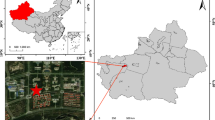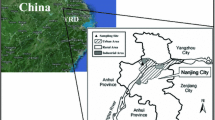Abstract
Tianjin is the third largest megacity and the fastest growth area in China, and consequently faces the problems of surface ozone and haze episodes. This study measures and characterizes volatile organic compounds (VOCs), which are ozone precursors, to identify their possible sources and evaluate their contribution to ozone formation in urban and suburban Tianjin, China during the HaChi (Haze in China) summer campaign in 2009. A total of 107 species of ambient VOCs were detected, and the average concentrations of VOCs at urban and suburban sites were 92 and 174 ppbv, respectively. Of those, 51 species of VOCs were extracted to analyze the possible VOC sources using positive matrix factorization. The identified sources of VOCs were significantly related to vehicular activities, which specifically contributed 60% to urban and 42% to suburban VOCs loadings in Tianjin. Industrial emission was the second most prominent source of ambient VOCs in both urban and suburban areas, although the contribution of industry in the suburban area (36%) was much higher than that at the urban area (16%). We conclude that controlling vehicle emissions should be a top priority for VOC reduction, and that fast industrialization and urbanization causes air pollution to be more complex due to the combined emission of VOCs from industry and daily life, especially in suburban areas.
Similar content being viewed by others
References
Agency for Toxic Substances and Disease Registry (ATSDR), 1997: Toxicological profile for benzene (update). Agency for Toxic Substances and Disease Registry, Public Health Service, U. S. Department of Health and Human Services, Atlanta, G. A.
Atkinson, R., 2000: Atmospheric chemistry of VOCs and NOx. Atmos. Environ., 34, 2063–2101.
Barletta, B., S. Meinardi, F. S. Rowland, C. Chan, X. M. Wang, S. C. Zou, L. Y. Chan, D. R. Blake, 2005: Volatile organic compounds in 43 Chinese cities. Atmos. Environ., 39, 5979–5990.
Brown, S. G., A. F. Frankel, and H. R. Hafner, 2007: Source apportionment of VOCs in the Los Angeles area using positive matrix factorization. Atmos. Environ., 41, 227–237.
Cai, C. J., F. H. Geng, X. X. Tie, Q. Yu, J. L. An, 2010: Characteristics and source apportionment of VOCs measured in Shanghai, China. Atmos. Environ., 44, 5005–5014.
Geng, F. H., C. S. Zhao, X. Tang, G. L. Lu, and X. X. Tie, 2007: Analysis of ozone and VOCs measured in Shanghai: A case study. Atmos. Environ., 41, 989–1001.
Geng, F. H., and Coauthors, 2008: Characterizations of ozone, NOX, and VOCs measured in Shanghai, China. Atmos. Environ., 42, 6873–6883.
Grosjean, E., R. A., Rasmussen, and D. Grosjean, 1999: Toxic air contaminants in Porto Alegre. Brazil Environ. Sci. Technol., 33, 1970–1978.
Guo, H., T. Wang, and P. K. K. Louie, 2004: Source apportionment of ambient non-methane hydrocarbons in Hong Kong: Application of a principal component analysis/absolute principal component scores (PCA/APCS) receptor model. Environmental Pollution, 129, 489–498.
Han, M., X. Q. Lu, L. Ran, C. S. Zhao, S. Q. Han, J. L. Bao, K. H. Zou, and F. Y. Yan, 2011: Source apportionment of volatile organic compounds in urban Tianjin in the summer. Environ. Sci. Tech., 34(10), 76–80. (in Chinese)
Harley, R. A., M. P. Hannigan, and G. R. Cass, 1992: Respeciation of organic gas emissions and the detection of excess unburned gasoline in the atmosphere. Environ. Sci. Tech., 26, 2395–2408.
Henry, R. C., 1997: History and fundamentals of multivariate air quality receptor models. Chemometrics and Intelligent Laboratory Systems, 37, 37–42.
Heo, J.-B., P. K. Hopke, and S.-M. Yi, 2009: Source apportionment of PM2.5 in Seoul, Korea. Atmos. Chem. Phys., 9, 4957–4971.
Kim, E., P. K. Hopke, and E. S. Edgerton, 2003: Source identification of Atlanta aerosol by positive matrix factorization. Journal of Air and Waste Management Association, 53(6), 731–739.
Latella, A., G. Stani, L. Cobelli, M. Duane, H. Junninen, C. Astorga, and B. R. Larsen, 2005: Semicontinuous GC analysis and receptor modeling for source apportionment of ozone precursor hydrocarbons in Bresso, Milan, 2003. J. Chromatography A., 1071, 29–39.
Liu, Y., M. Shao, J. Zhang, L. L. Fu, and S. H. Lu, 2005: Distributions and source apportionment of ambient volatile organic compounds in Beijing City, China. J. Environ. Sci. Health., Part A: Tox. Hazard. Subst. Environ. Eng., 40, 1843–1860.
Liu, Y., M. Shao, L. L. Fu, S. H. Lu, L. M. Zeng, and D. G. Tang, 2008a: Source profiles of volatile organic compounds measured in China: Part I. Atmos. Environ., 42, 6247–6260.
Liu, Y., M. Shao, S. H. Lu, C. C. Chang, J. L. Wang, and L. L. Fu, 2008b: Source apportionment of ambient volatile organic compounds in the Pearl River Delta, China: Part II. Atmos. Environ., 42, 6261–6274.
Lu, X. Q., M. Han, L. Ran, S. Q. Han, and C. S. Zhao, 2011: Characteristics of nonmethane organic compounds and their ozone formation potentials in downtown Tianjin in summer. Acta Scientiae Circumstantiae, 31(2), 373–380. (in Chinese)
Paatero, P., 1997: Least squares formulation of robust non-negative factor analysis. Chemome-trics and Intelligent Laboratory Systems, 37, 23–35.
Paatero, P., and U. Tapper, 1994: Positive matrix factorization: A non-negative factor model with optimal utilization of error estimates of data values. Environmetrics, 5, 111–126.
Polissar, A. V., P. K. Hopke, P. Paatero, W. C. Malm, and J. F. Sisler, 1998: Atmospheric aerosol over Alaska 2. Elemental composition and sources. J. Geophys. Res., 103(D15), 19 045–19 057.
Ran, L., and Coauthors, 2011: VOC reactivity and its effect on ozone production during the HaChi summer campaign. Atmos. Chem. Phys., 11, 4657–4667.
Song, Y., M. Shao, Y. Liu, S. H., Lu, W. Kuster, P. Goldan, and S. D. Xie, 2007: Source apportionment of ambient volatile organic compounds in Beijing. Environ. Sci. Technol., 41, 4348–4353.
Srivastava, A., A. E. Joseph, S. More, A. Patil, R. C. Dixit, and M. Prakash, 2005: Air toxics in ambient air of Delhi. Atmos. Environ., 39, 59–71.
Suthawaree, J., S. Kato, P. Pochanart, Y. Kanaya, H. Akimoto, Z. Wang, and Y. Kajii, 2012: Influence of Beijing outflow on volatile organic compounds (VOC) observed at a mountain site in North China plain. Atmos. Res., 111, 46–57.
Tie, X. X., F. H. Geng, L. Peng, W. Gao, and C. S. Zhao, 2009: Measurement and modeling of O3 variability in Shanghai, China: Application of the WRF-Chem model. Atmos. Environ., 43, 4289–4302.
Watson, J. G., J. C. Chow, and E. M. Fujita, 2001: Review of volatile organic compound source apportionment by chemical mass balance. Atmos. Environ., 35, 1567–1548.
Ye, W. H., X. H. Sun, J. S. Liu, H. F. Pan, and X. L. Pang, 2009: Study on air pollution of VOC in arterial traffic. Environmental Monitoring in China, 25(6), 87–89. (in Chinese)
Yuan, B., and Coauthors, 2012: Measurements of ambient hydrocarbons and carbonyls in the Pearl River Delta (RPD), China. Atmos. Res., 116, 93–104.
Yuan, Z. B., A. K. H. Lau, M. Shao, P. K. K. Louie, S. C. Liu, and T. Zhu, 2009: Source analysis of volatile organic compounds by positive matrix factorization in urban and rural environments in Beijing. J. Geophys. Res., 114, D00G15, doi: 10.1029/2008JD011190.
Author information
Authors and Affiliations
Corresponding author
Rights and permissions
About this article
Cite this article
Han, M., Lu, X., Zhao, C. et al. Characterization and source apportionment of volatile organic compounds in urban and suburban Tianjin, China. Adv. Atmos. Sci. 32, 439–444 (2015). https://doi.org/10.1007/s00376-014-4077-4
Received:
Revised:
Accepted:
Published:
Issue Date:
DOI: https://doi.org/10.1007/s00376-014-4077-4




